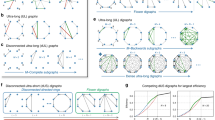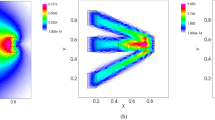Abstract
The travelling salesman problem1 is a classical problem in the field of combinatorial optimization, concerned with efficient methods for maximizing or minimizing a function of many independent variables. Given the positions of N cities, which in the simplest case lie in the plane, what is the shortest closed tour in which each city can be visited once? We describe how a parallel analogue algorithm, derived from a formal model2–3 for the establishment of topographically ordered projections in the brain4–10, can be applied to the travelling salesman problem1,11,12. Using an iterative procedure, a circular closed path is gradually elongated non-uniformly until it eventually passes sufficiently near to all the cities to define a tour. This produces shorter tour lengths than another recent parallel analogue algorithm13, scales well with the size of the problem, and is naturally extendable to a large class of optimization problems involving topographic mappings between geometrical structures14.
This is a preview of subscription content, access via your institution
Access options
Subscribe to this journal
Receive 51 print issues and online access
$199.00 per year
only $3.90 per issue
Buy this article
- Purchase on Springer Link
- Instant access to full article PDF
Prices may be subject to local taxes which are calculated during checkout
Similar content being viewed by others
References
Lawler, E. L., Lenstra, J. K., Rinooy Khan, A. H. G. & Shmoys, D. B. (eds) The Traveling Salesman Problem (Wiley, New York, 1985).
Von der Malsburg, Ch. & Willshaw, D. J. Proc. natn. Acad. Sci. U.S.A. 74, 5176–5178 (1977).
Willshaw, D. J. & Von der Malsburg, Ch. Phil. Trans. R. Soc. B287, 203–243 (1979).
Talbot, S. A. & Marshall, W. H. Am. J. Ophthal. 24, 1255–1264 (1941).
Gaze, R. M. The Formation of Nerve Connections (Academic, London, 1970).
Cowan, W. M. & Hunt, R. K. in The Molecular Basis of Neural Development (eds Edelman, G. M., Gall, W. E. & Cowan, W. M.) 389–428 (Wiley, New York, 1986).
Rose, J. E., Galambos, R. & Hughes, J. R. Bull. Johns Hopkins Hosp. 104, 211–251 (1959).
Knudsen, E. I. & Konishi, M. Science 200, 795–797 (1978).
Drager, U. C. & Hubel, D. H. J. Neurophysiol. 38, 690–713 (1975).
Wurtz, R. H. & Albano, J. E. A. Rev. Neurosci. 3, 189–226 (1980).
Garey, M. R. & Johnson, D. S. Computers and Intractability (Freeman, San Francisco, 1979).
Papadimitriou, C. H. Theor. Comput. Sci. 4, 237–244 (1977).
Hopfield, J. J. & Tank, D. W. Biol. Cybern. 5, 141–152 (1985).
Mitchison, G. J. & Durbin, R. SIAM J. alg. disc. Meth. 7, 571–582 (1986).
Kirkpatrick, S., Gelatt, C. D. & Vecchi, M. P. Science 220, 671–680 (1983).
Kirkpatrick, S. J. statist. Phys. 34, 975–986 (1984).
Lin, S. & Kernighan, B. W. Oper. Res. 21, 498–516 (1973).
Leuenberger, D. G. Introduction to Linear and Nonlinear Programming (Addison-Wesley, Reading, Massachusetts, 1984).
Christofides, N. in The Traveling Salesman Problem (eds Lawler, E. L., Lenstra, J. K., Rinnooy Khan, A. H. G. & Shmoys, D. B.) 431–448 (Wiley, New York, 1985).
Julesz, B. Foundations of Cyclopean Vision (University of Chicago, 1971).
Marr, D. & Poggio, T. Proc. R. Soc B204, 301–328 (1979).
Hubel, D. H. & Wiesel, T. N. Proc. R. Soc. B198, 1–59 (1977).
Law, M. I. & Constantine-Paton, M. J. Neurosci. 7, 741–759 (1981).
Fawcett, J. W. & Willshaw, D. J. Nature 296, 350–352 (1982).
Von der Malsburg, Ch. & Willshaw, D. J. Expl Brain Res. (Suppl.) 1, 463–469 (1976).
Von der Malsburg, Ch. Biol. Cybern. 32, 49–62 (1979).
Swindale, N. V. Proc. R. Soc. B208, 243–264 (1980).
Kohonen, T. Self-organisation and Associative Memory (Springer, Berlin, 1984).
Brady, R. M. Nature 317, 804–806 (1985).
Author information
Authors and Affiliations
Rights and permissions
About this article
Cite this article
Durbin, R., Willshaw, D. An analogue approach to the travelling salesman problem using an elastic net method. Nature 326, 689–691 (1987). https://doi.org/10.1038/326689a0
Received:
Accepted:
Issue Date:
DOI: https://doi.org/10.1038/326689a0
This article is cited by
-
Ant Colony Algorithm with n-\(\alpha \)-Measure and Migration Learning
Arabian Journal for Science and Engineering (2023)
-
Ant colony algorithm with Stackelberg game and multi-strategy fusion
Applied Intelligence (2022)
-
NEURO-LEARN: a Solution for Collaborative Pattern Analysis of Neuroimaging Data
Neuroinformatics (2021)
-
Adaptive Dynamic Probabilistic Elitist Ant Colony Optimization in Traveling Salesman Problem
SN Computer Science (2020)
-
A Lévy expansion strategy optimizes early dune building by beach grasses
Nature Communications (2019)
Comments
By submitting a comment you agree to abide by our Terms and Community Guidelines. If you find something abusive or that does not comply with our terms or guidelines please flag it as inappropriate.



